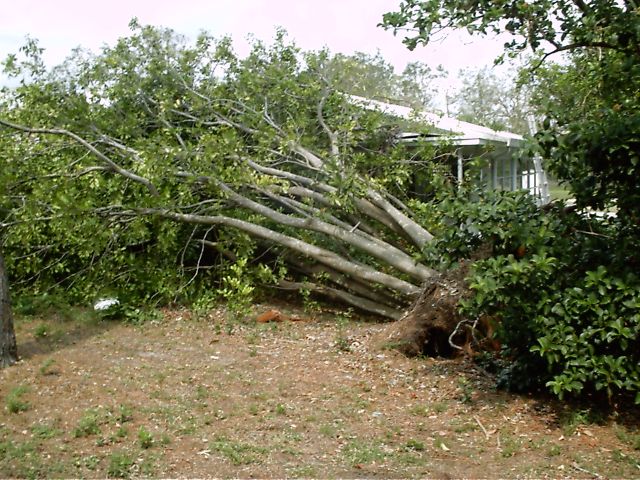
The Problem - Tree downed by hurricane leans against my parents retirement place in Florida. It's still alive and doing well four months later. Cutting it up and hauling it away is just way-too-much work (and expensive). Since the tree is still alive, why not just stand it back up again... |
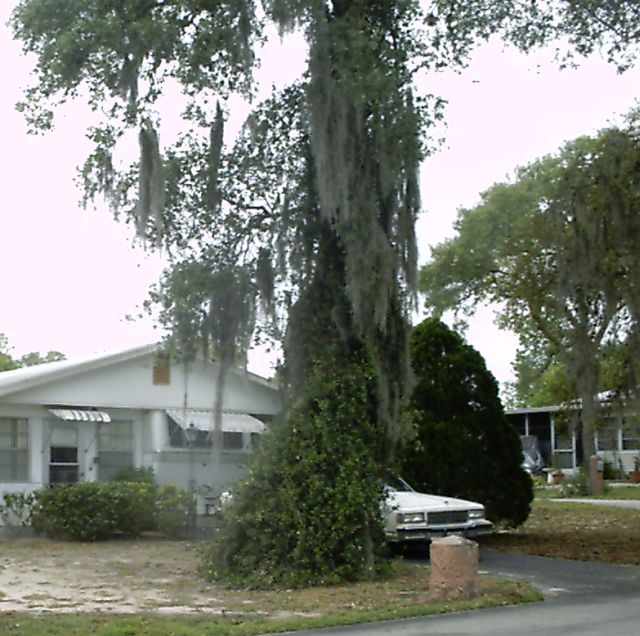
That wasn't the only problem. This other tree out front also went down. However... it fell away from the house and onto the road. Since it went down onto the 'common area' the condo association dealt with it, leaving me with only one problem to solve. (This photo taken six months before all the hurricanes hit. The tree was removed by the association before I flew down there to deal with the problems.) |
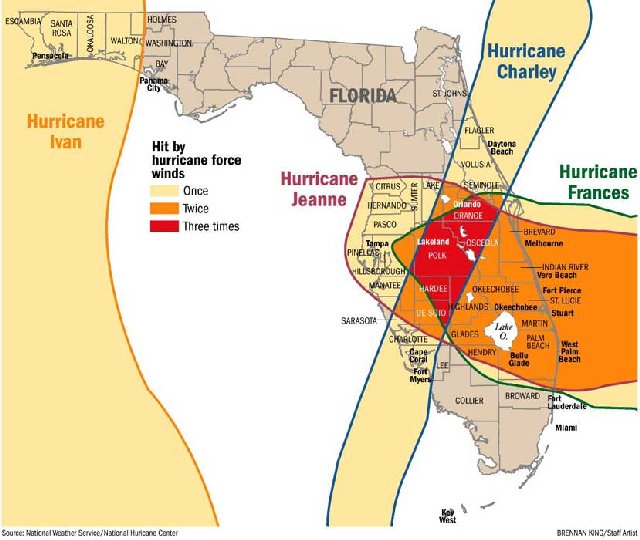
The Cause - During the 2004 Hurricane Season, Forida was hit by four hurricanes, Central Florida experienced hurricane force winds three times. |
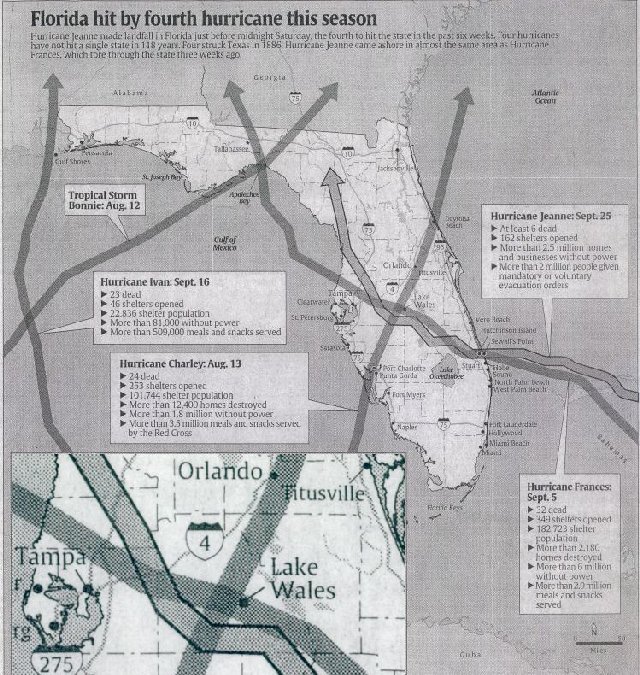
The Lake Wales Area in particular was hit hard as the eyes from three of the storms criss-crossed directly over the area. |
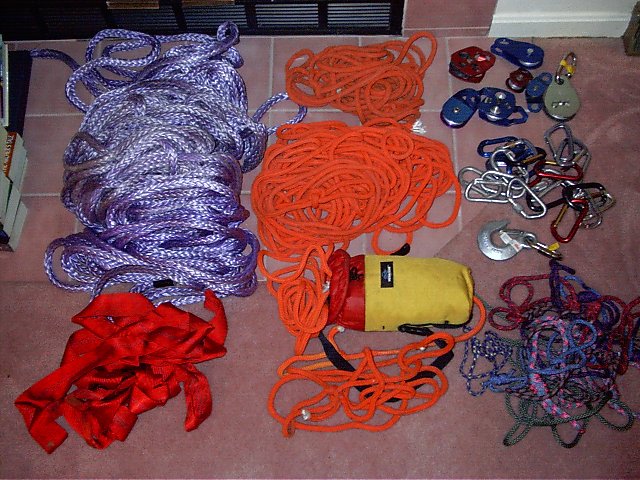
The Solution—A Z-Drag winching system, normally used for mountaineering or river-rescue situations. (Normally you'd just hire some guys to cut up and haul away the tree. However, in Florida after getting hit with multiple hurricanes, it was impossible to hire anyone, or find a chain saw for sale, or especially find blue waterproof tarp for sale. So, instead it was easier and way, way cheaper to buy some more rescue equipment. And now I still have the equipment!!!) |
| Main haul line: 220' of 1/2" Plasma-Spectra blend (85' for brake, 135' for main Z-Drag). Rope from Puget Sound Rope. Rated tensile strength 31,300 lbs, maximum stretch less then 1.5% at 50% load. This might sound like overkill, but for rigging systems like this the manufacturer recommends a 4:1 safety margin. | Misc lengths 3/8" Spectra (used all over). | Rescue pulleys, seven total. Available from places such as Rescue Systems, Inc. or Rescue Tech. |
| Cradle line, 100' of 3/8" Spectra (wrapped around the tree four times). Rated tensile strength 13,900 lbs, maximum stretch less than 4% at 50% load. | About twenty-five assorted carabiners. Available from EMS, REI, NRS, and other speciality outdoor stores. | |
| Anchor: 25' of 2" tubular webbing. Rated tensile strength 8,000 lbs. Double wrapped and secured with a water knot. Available from On Rope 1, and most mountaineering speciality outdoor retailers. | Auxiliary line, 75' of 3/8" Spectra (in bag). Used when initially setting/removing Z-Drag for safety and stability. | Assorted prusik cords. (Most 3/16" to 5/16" with tensile strength of 3,000-6,000 lbs.) Available from Pelican Rope Works. |
| Attachment line (connects Haul Line to Jeep). Short length 3/8" Spectra. |
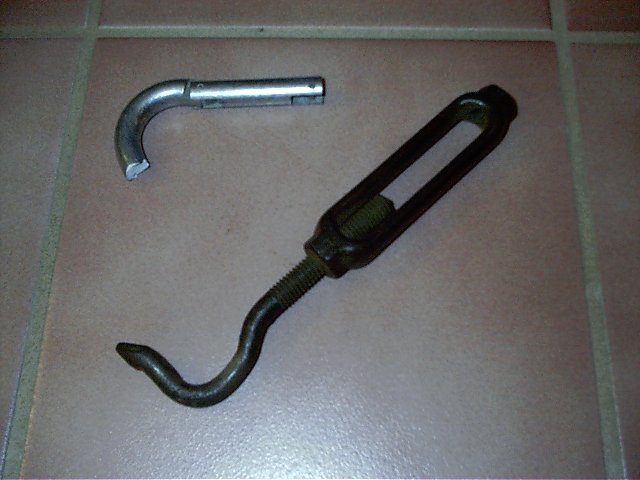
The first attempt resulted in equipment failure (broken beaner). For the second attempt all beaners in critical or high-load positions were doubled up. |
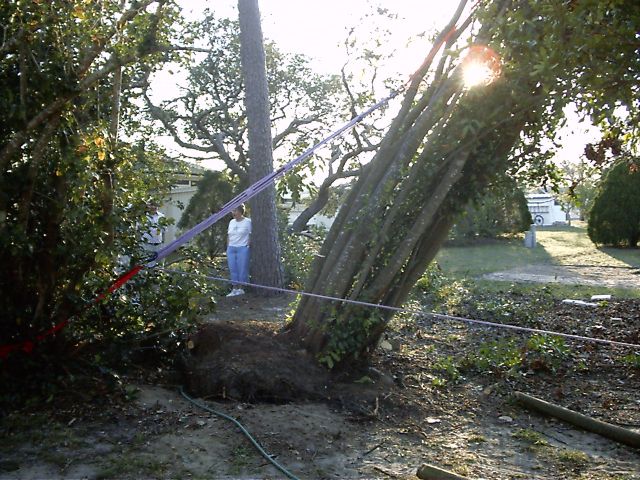
After two days of work, tree is almost all the way up. Prep work took about a day-and-a-half, (including thinning the tree by about 25 percent). An auto bumper jack was also used to "help" raise the tree the first foot or so and reduce the angle (and resultant strain) on the rope. Setting Z-drag and raising tree took about 3 hours. The main haul line and brake are shown here. The seven rescue pulleys used when setting the Z-Drag provided a mechanical advantage of 43:1. (I.E, A 200 lb pull from the Jeep translates to about 8,600 lbs of force on the tree.) The two prusiks (and beaners) securing the brake line are barely visible directly in the center of the line (with the other tree in the background.) Estimated weight of the tree is in the range of 3000 to 7000 lbs (a very rough guess). |
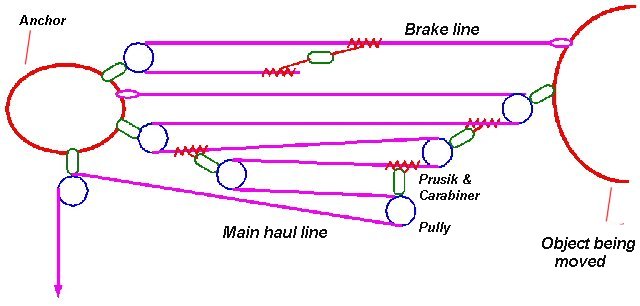
Diagram showing typical z-drag configuration; this one with a 22:1 mechanical advantage. (General rule of thumb: Each pully attached via prussic after the initial two (fixed to the object and anchor) almost doubles the mechanical advantage (ignore the final pully above which is also fixed to the anchor and doesn't add anything additional). Two pullys provide a 3:1 advantage, three provide a 6:1, four is 11:1, five is 22:1, six 43:1, seven 86:1, etc, etc.) The total mechanical advantage also is the ratio of haul line movement vs object movement. (I.E. for every foot the object moves the haul line moves twenty-two feet.) [Note: An approximate formula to calculate the mechanical advantage is "3*(2^(NumberPullys-2))-10%", or three times (two raised to the power of (pullys minus two)), less ten percent.] |
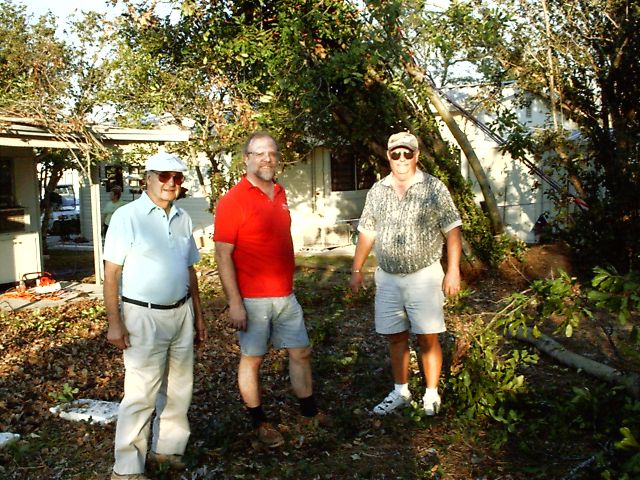
The "crew", Sam, Skip and Bob. Bob's Jeep provided the muscle after the Chevy proved to not have enough oomph. (Notice that none of these guys were born yesterday, just goes to prove that "old" does not necessarily mean "over the hill"...) |
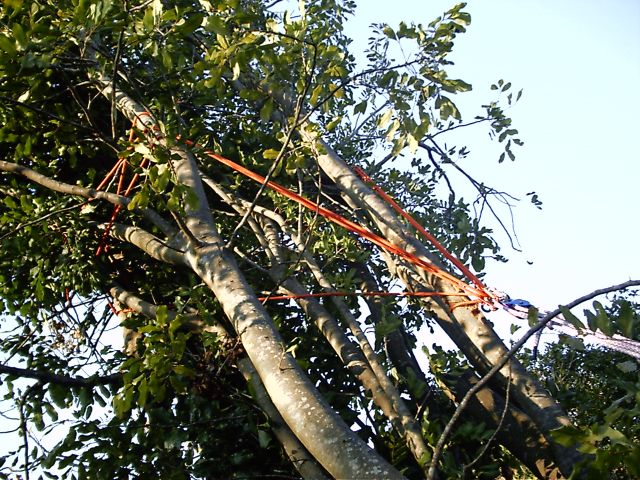
The cradle was formed with a 100' length of 3/8" spectra line wrapped around the tree four times, secured to the larger trunks, the two ends connected with two 28KN beaners. |
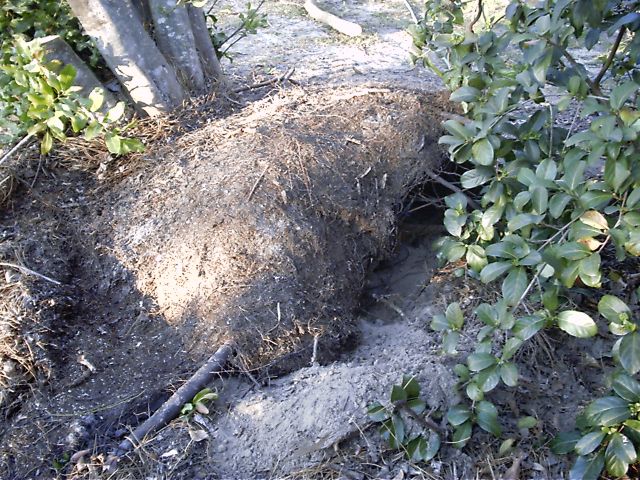
There was quite a hole in the ground, about half of the roots survived. |
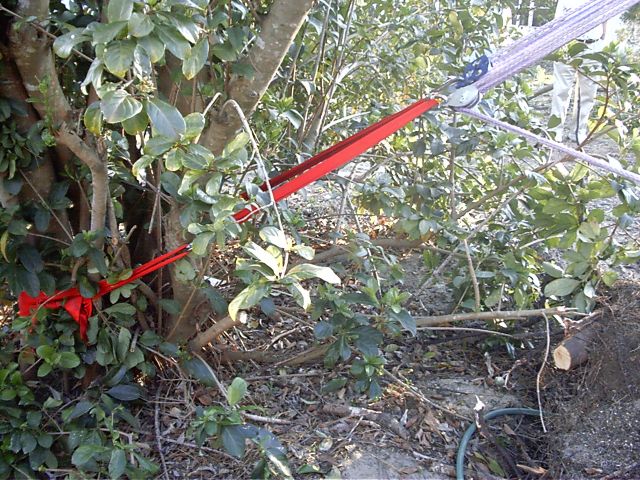
The anchor was 2" webbing, double wrapped, tied with a water knot and secured with two 34KN beaners. Note both the brake line (blue pulley) next to the main haul line, each secured to anchor with two beaners. |
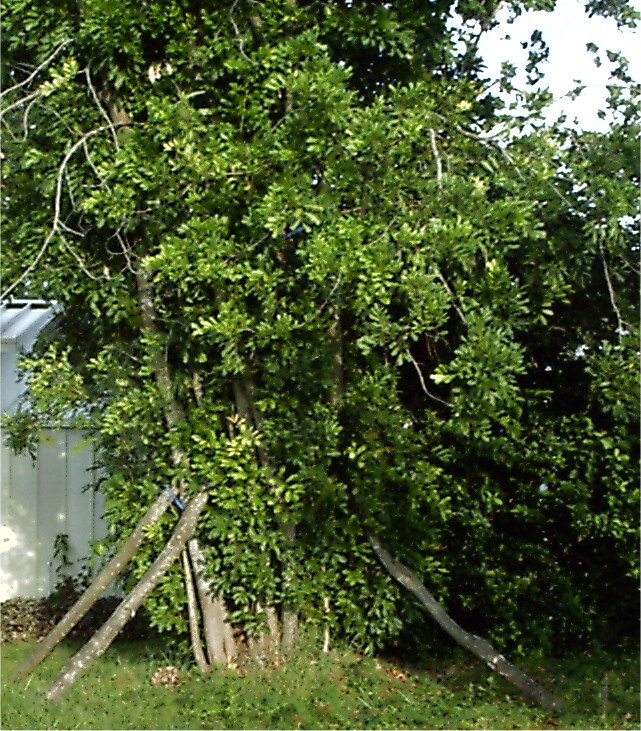
| Six months later the tree is doing fine. |
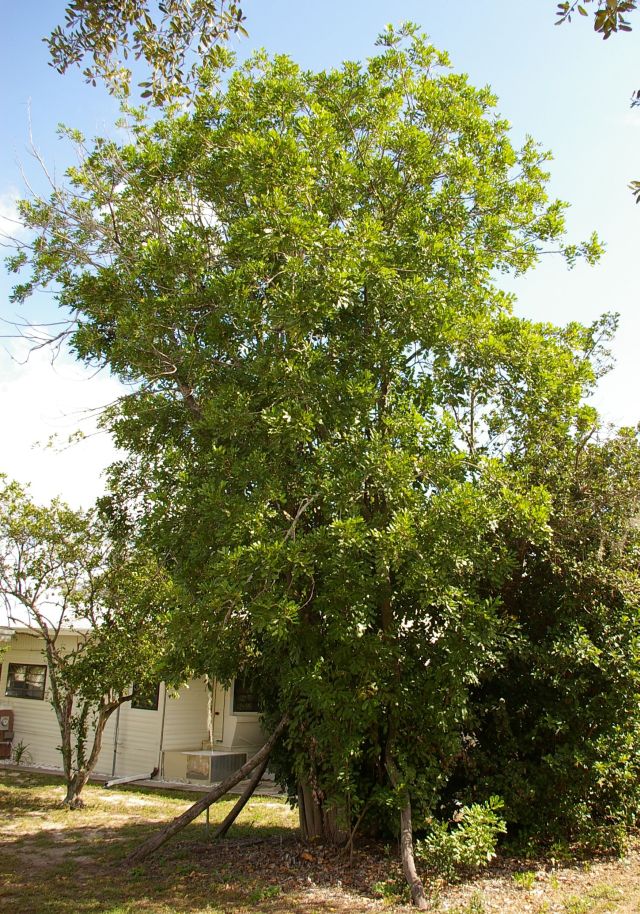
| This photo taken October 2007, almost three years after the tree was righted. (The lateral supports were removed right after this photo was taken. They weren't required to hold the tree up, only to try and direct it away from the house if another hurricane hit.) |